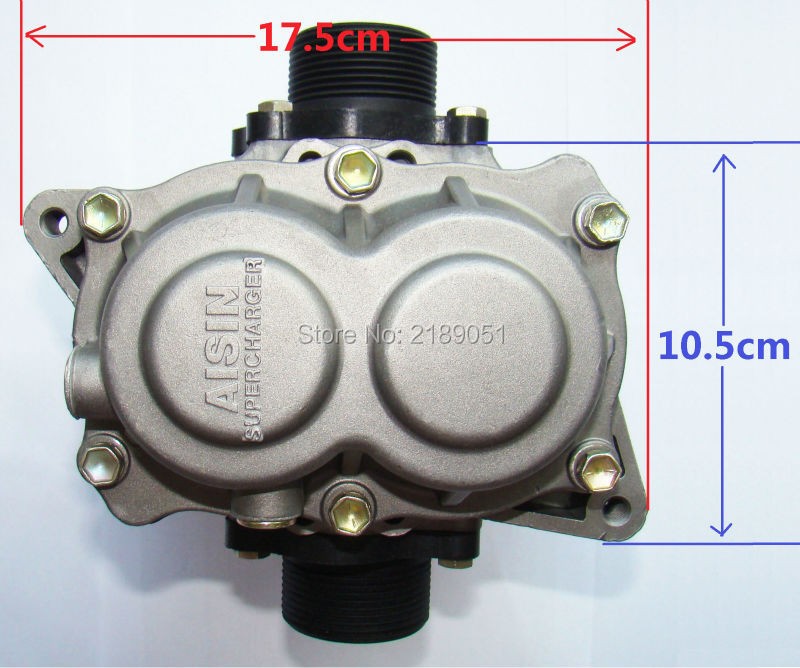Choosing the right forced induction system for your project car involves careful consideration of various factors. This article delves into the intricacies of using a roots-type supercharger, specifically the Aisin AMR 300 AMR300, for enhancing engine performance. We’ll explore its characteristics, potential challenges, and tuning considerations. This compact unit, measuring approximately 7 inches wide and 6 inches tall, offers a volumetric approach to boosting, differing significantly from centrifugal superchargers and turbochargers.
Understanding the Aisin AMR 300 AMR300 Supercharger
The Aisin AMR 300 is a roots-type supercharger, meaning it utilizes two meshing rotors to compress air. This mechanical design results in a linear boost curve, simplifying carburetor tuning compared to the non-linear boost of centrifugal compressors. Its compact size makes it adaptable for various engine bays. The intake and outlet ports, located on the top and bottom, contribute to the overall dimensions. Driving this supercharger requires a robust system, likely utilizing either a chain or belt drive. While a chain drive might seem logical for applications already employing chains, the inherent noise could overshadow the desirable supercharger whine. A belt drive offers a quieter operation, potentially requiring only pulley modifications to integrate with an existing setup. Addressing potential belt slip is crucial; a tensioner system is recommended to maintain optimal performance and prevent catastrophic failure.
 alt text: Aisin AMR300 Supercharger
alt text: Aisin AMR300 Supercharger
Comparing Supercharging to Turbocharging
While a turbocharger, such as the VZ21, might seem like a viable alternative, the inherent complexities of turbocharging a small engine often outweigh the benefits. Turbochargers require exhaust gas routing and oil lubrication, adding complexity to the installation and tuning process. The Aisin AMR 300’s simplicity and linear boost characteristics make it a more suitable choice for forced induction in this context. Furthermore, the readily available information and community support surrounding the AMR 300 contribute to its appeal.
Addressing Low RPM Challenges with the AMR 300
The Aisin AMR 300, with its two-lobe rotor design, may present efficiency challenges at low RPM. The less-than-perfect seal between the rotors and the housing can lead to reduced vacuum and power output. This, coupled with the inherent low power of small engines at low RPM and the added load of the supercharger itself, can result in sluggish initial acceleration. A potential solution to mitigate this issue is incorporating a bypass valve. This valve would allow air to bypass the supercharger at low RPM, improving engine response and drivability until the engine reaches a speed where the supercharger becomes more efficient.
Tuning Considerations for the AMR 300
Tuning the AMR 300 involves careful consideration of fuel delivery. While modern fuel injection systems offer precise control, the traditional carburetor route, leveraging the Venturi effect, remains a viable option for this application. The linear boost characteristic of the AMR 300 simplifies carburetor tuning, making it a more manageable task compared to tuning for the non-linear boost of a turbocharger or centrifugal supercharger. The key lies in ensuring adequate fuel delivery across the RPM range to match the increased airflow provided by the supercharger. Proper jetting and careful adjustments are crucial for achieving optimal performance and avoiding detonation.
Conclusion
The Aisin AMR 300 AMR300 offers a compelling solution for enthusiasts seeking to add forced induction to their small engine projects. Its compact size, linear boost characteristics, and relative simplicity make it a viable alternative to more complex turbocharger setups. Understanding the potential challenges at low RPM and addressing them with solutions like a bypass valve are crucial for a successful implementation. Finally, meticulous tuning, whether through carburetion or fuel injection, is paramount to unlock the full potential of the AMR 300 and achieve desired performance gains.

